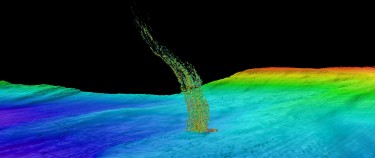
Warming ocean temperatures a third of a mile below the surface, in a dark ocean in areas with little marine life, might attract scant attention. But this is precisely the depth where frozen pockets of methane ‘ice’ transition from a dormant solid to a powerful greenhouse gas.
New University of Washington research, whose lead author is UW professor of oceanography H. Paul Johnson, suggests that subsurface warming could be causing more methane gas to bubble up off the Washington and Oregon coast.
The study that will appear in the journal Geochemistry, Geophysics, Geosystems from the American Geophysical Union, shows that of 168 bubble plumes observed within the past decade a disproportionate number were seen at a critical depth for the stability of methane hydrates.
If methane bubbles rise all the way to the surface, they enter the atmosphere and act as a powerful greenhouse gas. But most of the deep-sea methane seems to get consumed during the journey up. Marine microbes convert the methane into carbon dioxide, producing lower-oxygen, more-acidic conditions in the deeper offshore water, which eventually wells up along the coast and surges into coastal waterways.
Read more at UW Today »
